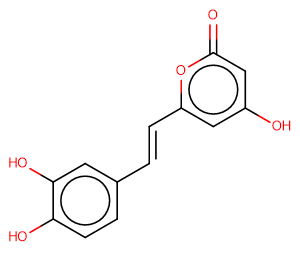
Hispidin
CAS No. 555-55-5
Hispidin( —— )
Catalog No. M21068 CAS No. 555-55-5
Hispidin is a polyphenol originally including antioxidant anti-inflammatory and cytoprotective properties.
Purity : >98% (HPLC)
 COA
COA
 Datasheet
Datasheet
 HNMR
HNMR
 HPLC
HPLC
 MSDS
MSDS
 Handing Instructions
Handing Instructions
| Size | Price / USD | Stock | Quantity |
| 5MG | 215 | Get Quote |


|
| 10MG | 356 | Get Quote |


|
| 25MG | 597 | Get Quote |


|
| 50MG | 836 | Get Quote |


|
| 100MG | 1125 | Get Quote |


|
| 200MG | Get Quote | Get Quote |


|
| 500MG | Get Quote | Get Quote |


|
| 1G | Get Quote | Get Quote |


|
Biological Information
-
Product NameHispidin
-
NoteResearch use only, not for human use.
-
Brief DescriptionHispidin is a polyphenol originally including antioxidant anti-inflammatory and cytoprotective properties.
-
DescriptionHispidin is a polyphenol originally including antioxidant anti-inflammatory and cytoprotective properties.
-
In Vitro——
-
In Vivo——
-
Synonyms——
-
PathwayAngiogenesis
-
TargetPKC
-
RecptorPKCβ
-
Research Area——
-
Indication——
Chemical Information
-
CAS Number555-55-5
-
Formula Weight246.22
-
Molecular FormulaC13H10O5
-
Purity>98% (HPLC)
-
SolubilityIn Vitro:?DMSO : 19.23 mg/mL (78.10 mM)
-
SMILESO=c1cc(O)cc(/C=C/c2ccc(O)c(O)c2)o1
-
Chemical Name6-(34-Dihydroxystyryl)-4-hydroxy-2-pyrone
Shipping & Storage Information
-
Storage(-20℃)
-
ShippingWith Ice Pack
-
Stability≥ 2 years
Reference
1.Jang J S Lee J S Lee J H et al. Hispidin produced from Phellinus linteus protects pancreatic β-cells from damage by hydrogen peroxide[J]. Archives of Pharmacal Research 2010 33(6):p.853-861.
molnova catalog



related products
-
PKC beta II inhibito...
PKC-IN-1 is a poent PKC beta II inhibitor with Ki of 14.9 nM.
-
D-ERYTHRO-SPHINGOSIN...
D-erythro-Sphingosine is a protein kinase C (PKC) inhibitor. D-erythro-Sphingosine (Erythrosphingosine) is also a PP2A activator.
-
LY379196
LY379196 is a highly specific PKCβ inhibitor with IC50 of 30-50 nM for PKCβI and PKCβII.



 Cart
Cart
 sales@molnova.com
sales@molnova.com


